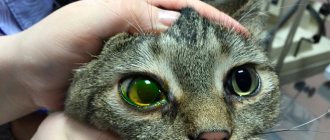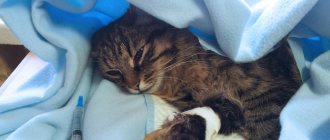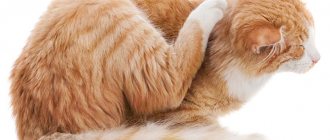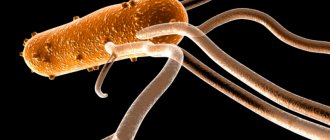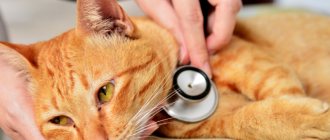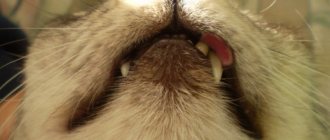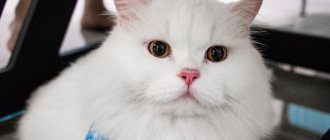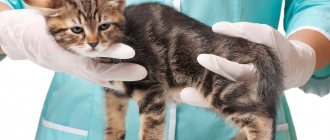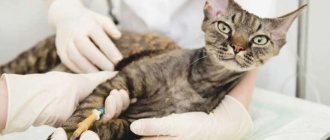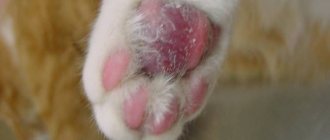When getting a pet, its owner must understand that a little furry requires care, attention and trouble. Especially if he gets sick. Even pets who are constantly at home are at risk. And a cat walking on the street - even more so. By contacting yard animals there, she can pick up some disease that can be transmitted to humans. Such diseases include ringworm or trichophytosis in cats. What kind of disease is this, how is it dangerous for a pet, what are the symptoms and is it transmitted to humans?
Causes and routes of transmission
Microsporia in cats is more common than other skin diseases. The fungi that cause lichen are very tenacious. In soil they remain viable for up to two years. The pathogen is present on the grass, fur of infected animals, and surfaces that the sick cat has come into contact with. Even a cat that has never been outside and has not been in contact with other animals can become infected.
Most often, the infection is brought by the owner on shoes and clothes.
The fungus does not pose a serious danger to an adult animal with a strong immune system. In a healthy cat, the infection becomes more active due to stress and after vaccination. There is a high risk of contracting ringworm in kittens (their immunity is not yet fully developed), as well as cats weakened due to poor living conditions and poor quality nutrition. The presence of abrasions and wounds on a cat’s skin also increases the likelihood of contracting lichen.
Main symptoms
The disease may not appear immediately after infection, but the fungus will definitely make itself known sooner or later.
The main signs of trichophytosis or microsporia in cats:
- The appearance of whitish skin flakes or dandruff in certain areas of the head or body.
- Hairless patches on the head, face, legs or back.
- Itching in the affected area.
- The claws peel off and turn brown.
- Ruffled fur.
- The appearance of suppuration on wounds where hair has fallen out (with prolonged absence of treatment).
- Sad looking pet.
Symptoms of ringworm in cats
Microsporia or trichophytosis in cats can have several forms:
- hidden – affects adult animals, hardly noticeable;
- erased – the disease is mild, small areas of skin without hair are noticeable;
- superficial – one or more bald areas, broken hairs, subtle inflammation of the skin are noticeable;
- follicular - with large foci of baldness, the presence of crusts, ulcers on the surface of the skin.
The first signs of lichen can be seen near the paws, near the tail and on the cat’s face. Hairless spots appear there. At the beginning of the disease, the animal’s skin remains clean, but later redness and scales appear. If you pull the fur on the inflamed area, it will easily be pulled out without causing pain to the cat. Without treatment, the spots spread throughout the body, and the inflamed skin begins to fester.
When the form of lichen is hidden and erased, it is more difficult to identify. To do this, you need to pay attention to what the cat's hair looks like. If a cat, even without patches of baldness, looks disheveled, dandruff appears, the fur becomes matted, and loses its shine, you should suspect microsporia or trichophytosis and contact a veterinarian for examination.
Ringworm, regardless of its form, weakens the animal's immunity. Therefore, the disease should be identified and your pet treated as early as possible.
What is trichophytosis
Ringworm or trichophytosis is a fungal disease. The causative agent is protozoan parasites - fungi. They have a filamentous body with a large number of spores, which leads to lightning-fast spread of infection. Everything that the animal touched where hairs of its fur could be found (bedding, household items, carpets) remains strewn with trichophyte spores. The pathogen is viable even to high temperatures and most disinfectants. Unfortunately, this infection can be contagious to people.
Diagnostic methods
A visual examination of the animal only allows one to suspect ringworm. This disease can easily be confused with other types of mycoses, as well as weeping eczema or allergies. The disease can be confirmed only after diagnosis. The veterinarian knows exactly how to identify ringworm.
The easiest way to identify lichen is to use a Wood's lamp. Its light is directed to the affected area of the skin. If there are fungi on it that cause microsporia and trichophytosis in cats, an emerald green glow is noticeable.
A more reliable analysis is carried out in the laboratory. The material obtained by scraping the skin immediately or after growing on a nutrient medium is examined under a microscope.
Treatment
The therapeutic concept is determined by the form of the disease. The exact diagnosis and stage of Trichophytosis is determined by a veterinarian. In mild cases, they are treated with external preparations in the form of ointments, aerosols or shampoos. When Trichophytosis is advanced, internal remedies are prescribed. If several cats live in an apartment, they will also have to be treated. A veterinarian caring for a pet must take care of himself: wear gloves and, if possible, a change of clothes. All objects that came into contact with a sick cat are regularly disinfected with chlorine-containing detergents and wet cleaning is carried out.
Trichophyton spores are extremely survivable and can cause re-infection. Combined treatment with external and oral drugs is used. The treatment areas are trimmed. Licking is prevented by wearing an Elizabethan collar.
External means
The following forms and names of drugs are used:
- Ointments:
- Yam.
- Mycozon.
- Sanoderm.
- Sprays:
- Exoderil. Clean the skin from crusts with Perhydrol or Furacilin solution, blot and apply an aerosol. Process twice. The course of treatment is 1...2 weeks.
- Fungin. Effective when applied daily for 2 weeks. Contraindicated in aging and lactating cats.
- Shampoos.
- Nizoral. Intended for bathing the animal, after which the inflamed area is treated with Nizoral cream. Treatment of the cat lasts 14…28 days.
- Solutions
- Imaverol. Before use, prepare a working emulsion. The first use is bathing the cat. The next three are carried out with an interval of 4 days. The animal is generously sprayed with a solution of the drug. You can treat kittens, pregnant and nursing mothers.
- Fucoricin. Apply with swabs or cotton swabs three times until the sores disappear. Together with fungi, it destroys bacteria.
- Oral antimycotics are toxic to kittens and are prohibited for gestational and lactating animals. The drugs are used according to the instructions. The following funds are in demand:
- Griseofulvin.
- Irunin.
- Intraconazole.
- Flucanazole.
- Ketaconazole.
Prevention
The main preventive method is compliance with the rules of housing and feeding. Before events with large crowds of animals, immunostimulants are used. There are no reliable vaccines against Trichophytosis. Biological products produced by Russian industry are not used outside the country.
Is cat lichen dangerous for humans?
Veterinarians and dermatologists always give an affirmative answer to the question of whether a fungus is transmitted from a cat to a person. The disease is contagious. The incubation period for infection acquired from an animal is 5 to 7 days. But after contact with an infected cat, not everyone gets sick.
The fungus is dangerous for children, as well as weakened people with a low level of immune defense. Almost always people who get lichen are those who have fresh wounds on their skin during contact with animals.
Timely treatment of lichen allows you to get rid of it in 3-5 weeks. An advanced disease leads to bald spots on the head, suppuration, and later – scars on open areas of the skin.
Causes
A cat becomes vulnerable to attack by fungi of the genus Trichophyton if its immune defense is weakened. This occurs in the following situations:
recommended articles:
- Grooming a cat, is it worth using scissors?
- Papillomas and warts in cats
- Infection. In this case, micromycetes act as secondary microflora.
- Consequences of treatment with antibiotics and steroidal antiphlogistants. Competing bacterial microflora is inhibited, now nothing interferes with the development of Trichophytons.
- Unbalanced cat feeding. Protein deficiency or poor quality prevents the formation of antibodies.
How to distinguish from other types of lichen
Cats get sick not only from ringworm, the most common, but also from other types of lichen. All of them have characteristic manifestations:
- The pityriasis (multi-colored) form of the disease often occurs in cats with increased oily skin, as well as in animals living in hot climates. It develops due to the active reproduction of yeast fungi in the upper layers of the skin. It appears as spots of different shapes on the skin. Their color can be pink, yellow, brownish.
- Lichen planus develops when there is a malfunction in the immune system. On the surface of the cat’s skin and mucous membranes, areas appear covered with flat, smooth, red bubbles; they have a depression in the center. The disease is not contagious.
- Pityriasis rosea is viral in nature. At the beginning of the disease, one large, hairless, pink plaque (maternal) appears on the cat’s body. Later, many smaller lesions appear. They are very itchy and covered with scales. The disease is transmitted to other animals.
- Ringworm (eczema) is not contagious. It can be caused by an allergy or a bacterial agent. It begins with the appearance of redness and itchy blisters on the skin. Scratching causes them to burst, liquid comes out, and later pustules and crusts form.
First signs
The first signs of infection are difficult to notice, especially in long-haired and fluffy cats. They appear as a rash or slight redness on the skin, which the pet begins to scratch at first. Basically, the disease manifests itself already at the stage of hair loss.
The incubation period lasts from 1 week to 1 month. On animals it can be seen almost immediately. It appears in the form of bald spots with redness on the skin, hence the second name of the disease, ringworm. Mostly, such bald patches appear on the animal’s head and neck; in rare cases, the limbs and tail are damaged.
If the disease is advanced, the spots spread to the entire body and after a while unite. The animal loses a large part of its fur. Also, the redness becomes covered with a crust, under which suppuration of the hair follicles begins and pus accumulates. Basically, with this disease there is no itching.
Treatment of microsporia and trichophytosis in cats
How and with what to treat ringworm is determined by the veterinarian. When prescribing internal and external remedies, the doctor takes into account the form of the disease, as well as the age and weight of the animal. It is possible to achieve recovery only if you strictly adhere to the specialist’s recommendations throughout the entire course of therapy. It lasts 4-6 weeks.
Drugs
Antifungal medications are used to treat ringworm in cats. Most often, doctors prescribe a combined regimen, which includes the use of ointments, sprays, shampoos, and tablets.
Bathing the animal with antifungal shampoo (Nizoral, Dermazol) is carried out every other day in the first week, then twice a week for 14 days. Spray (Nizoral, Imaverol, Dermazol) or ointment for ringworm (Clotrimazole, Miconazole, Lamisil) is applied to the affected areas 2-3 times a day.
It is necessary to ensure that after lubricating the skin with the medicine, the cat does not lick it off.
Fungin solution is used to treat the skin of a sick cat. It contains the antifungal component clotrimazole, as well as propolis. The medicine destroys fungi and promotes skin regeneration.
If external remedies for the treatment of lichen do not have an effect, as well as in advanced cases, doctors prescribe drugs in tablets - Fucis, Terbinafine. The veterinarian determines the dosage, frequency and duration of administration individually for each animal.
To treat lichen in cats, some veterinarians prescribe the vaccines Polivak, Mikoderm, Vakderm. There is no clear opinion among experts regarding the benefits of immunotherapy drugs for the prevention of lichen. But vaccines work well as an aid during treatment.
Folk remedies
Treatment at home is not as effective as therapy under the supervision of a veterinarian. But if it is not possible to contact a specialist, then traditional methods will help alleviate the pet’s condition.
Simple recipes that are used for lichen in cats:
- Ash from newsprint, raspberry or black currant branches (1 tbsp) is mixed with 3 drops of iodine and 5-10 drops of vegetable oil (the mass should have the consistency of thick sour cream). Apply the mixture to the affected area of skin 3 times a day.
- Mix 1 tsp. iodine, valerian tincture, sunflower oil. The resulting mixture is used to treat the cat's bald spots three times daily.
- 1 tablet of acetylsalicylic acid is dissolved in 30 ml of medical alcohol. A cotton swab is moistened in liquid and the cat’s skin is treated once a day for one week.
Do kittens get infected and how to treat them?
Kittens, like adult animals, are susceptible to infection. Treatment in this case is provided only with local agents for 2–3 weeks. The earlier therapy is started, the higher the likelihood of a quick recovery. To treat kittens and pets whose weight does not exceed 2 kg, Furacilin solution is most often used, as well as antifungal drugs: Fungin, Sanoderm, etc. It is important to ensure that the kitten does not lick the medicine. To do this, you can put a special protective blanket on it. Before each application of antifungal ointment or cream, it is necessary to clean the lesion using a Furacilin solution (0.02%), which is easy to prepare yourself.
Furacilin has an antiseptic effect
If there are several animals in the house, the infection can easily spread. It is important to isolate pets from contact with each other and regularly carry out wet cleaning using chlorine-containing products.
Additionally, special shampoos that produce an antifungal effect are used to treat kittens. These include Imaverol, Lime Sulfer, etc. Such products are not cheap, but they allow you to get good results. These shampoos should be used once a week for 2 months. The kitten should first be rinsed with warm water (39 degrees). Then apply a little shampoo to the entire surface of the coat and lather. Leave for a few minutes and rinse with water. To prevent the kitten from catching a cold, you need to wrap it in a towel and close all the windows.
Possible complications and consequences
Serious complications from ringworm occur only in small kittens without timely treatment. An animal weakened by infection becomes lethargic and refuses to eat. It may die if the infection takes a generalized form and spreads to internal organs.
For an adult cat, the disease is not so terrible. Even without treatment, the infectious process subsides 2-2.5 months after the start. But in order to achieve a complete recovery, careful care of the cat is necessary, following all the doctor’s instructions.
Disinfection and prevention
The incubation period for lichen is 2 weeks. Therefore, people who have taken a new pet into their home should quarantine it for this period - allocate a separate room, limit contact with household members. If you notice the first manifestations of the disease, immediately contact your veterinarian. The same must be done if a domestic cat is sick with trichophytosis or microsporia.
Contact with a sick animal should be done with gloves and a mask. After feeding and handling your cat, you should wash your hands thoroughly.
Fungal spores easily land on furniture and carpets. To prevent them from causing infection to all family members and other animals, thorough disinfection is necessary. The room is quartzed for 15-20 minutes several times a day. Smooth surfaces are wiped with Maxisan solution and chlorine-containing products.
Upholstered furniture is treated with hot steam several times. Spraying a mixture of tea tree and lavender essential oils through a spray bottle (10 drops of oil per 100 ml of water) helps kill spores in the air and on the surface of objects. For the next 3-4 weeks after treatment, the cat should be observed and its coat inspected.
Rules for cleaning an apartment or house
Since trichophytosis is dangerous for humans, you need to follow the rules for cleaning an apartment or house:
- Firstly, when doing any work in an “infected” house, you must use disposable gloves.
- Secondly, it is advisable to treat all curtains and even walls with a steam generator. We also recommend using Clinafarm smoke bombs. They are specifically designed to combat mycoses. We remind you that after using them, your home will have to be thoroughly ventilated.
If possible, add the same Ivamerol to the water when washing floors daily. When this is not available, any chlorine bleach will do. The concentration must be selected so that the product does not spoil the floor covering (i.e., use the maximum permissible concentration).
Vacuuming should also be done daily. It is advisable to change dust bags at least once every three days, destroying them by burning. All accessible parts of the vacuum cleaner must then be washed with bleach.
